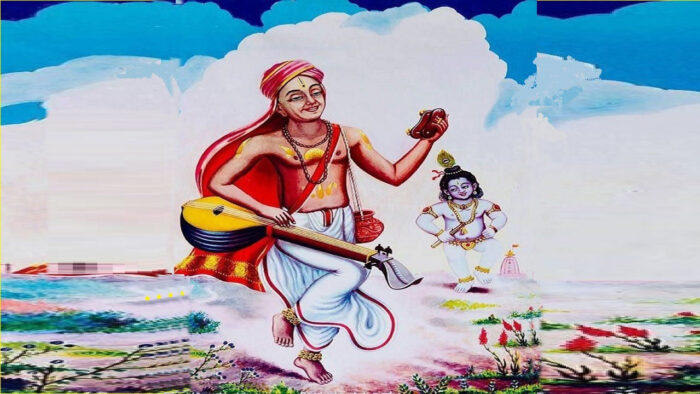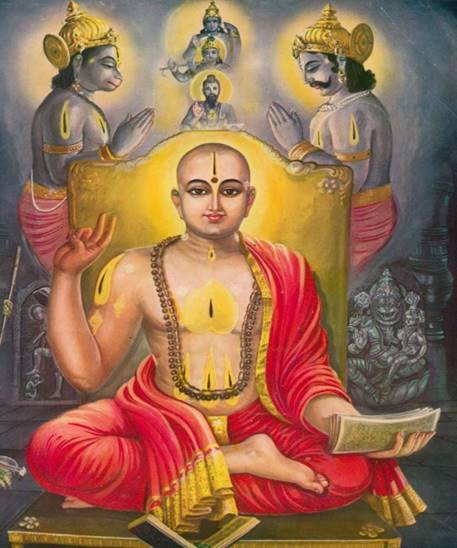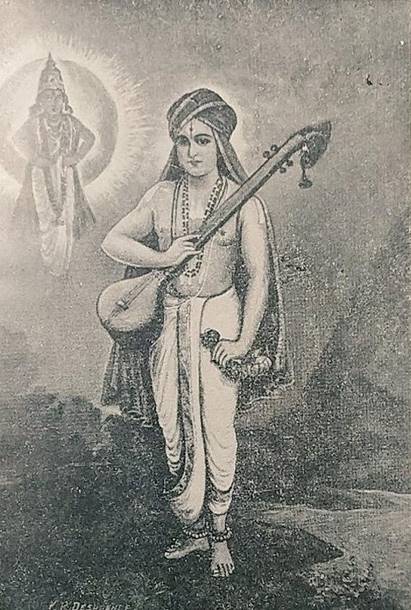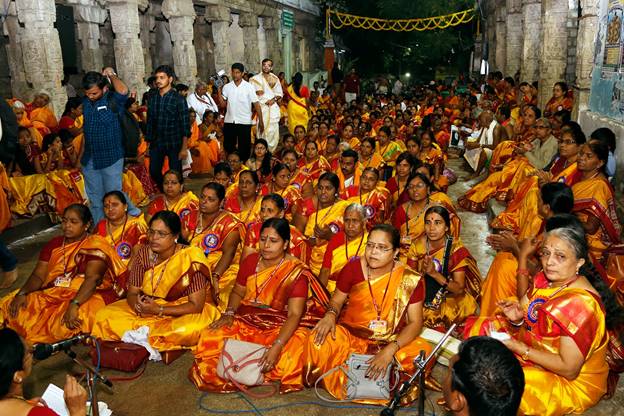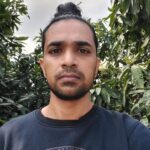Dasapadas are songs composed by people known as Haridasas who are initiated and trained in their respective schools of thought by the Peetadhipatis (Seers) or other Haridasas. Sri Narahari theertha (1324-1333 AD) who succeeded Sri Madhwacharya (Founder of Dvaita saampradaya) is regarded as the father of the Haridasa movement. Yaksha Gaana (folk dance) and Bayalata (street play) traditions from coastal Karnataka are also attributed to him. These traditions were developed with the aim of spreading the dharmic teachings among the masses. Dasapadas in particular have been used extensively in other parts of India by scholars such as Sri Vallabacharya (Founder of Shudda advaita vaishnava saampradaya) as a medium to propagate dharma.
Since the aim was to reach the masses who otherwise lacked even basic knowledge of Vedic scriptures due to paucity of time, adhikara and other reasons, the songs were composed in such a way that they were easy to sing, remember and understand. Haridasas developed their own styles of narration to make them more interesting and fun.
(Figure 1: Credit: Madhwa Saints. Sri Madhvaacharya)
The dasapadas of Karnataka have been traditionally passed down from one generation to another, particularly by women of the Madhwa community.
In this paper I wish to share my own experience of growing up, learning the stories and concepts of Vedanta from dasapadas sung by my grandmother and other women from my family and community.
Technically the dasapadas are categorized as keertane, suladi, ugabhoga, mundige etc. In this paper I will categorize them as follows:
- Songs that narrate a story.
- Songs that could be used in stories to make them more interesting and impactful.
- Songs that tell specific events in history.
- Songs that are passed down along with a story, telling why and when they were composed.
A unique attribute of Karnataka dasapadas is that they focus more on the gnaana aspect – gnaana as in gnaana, bhakti and vairagya. Thus the dasapadas will be very helpful to people who wish to learn stories or concepts narrated as explained in Vedic literature from an Indic perspective.
(Figure 2: Representational image of Sri Purandara dasa with Tamburi, Chitike (castanets) in one hand each and Gejje (anklets) tied to feet. A Bhiksha patra can be seen hanging around near chitike)
Lakshanas of a Haridasa
Sri Purandara dasa has composed a small dasapada describing the lakshanas of a dasa. This pada is not merely for knowing what a dasa is – rather I see it is an assurance given by dasasreshta (foremost of dasas) himself to the people, that haridasas have seen Sri Hari and this path if followed by the rest, will surely lead them to vaikunta (moksha).
Tamburi Meetidava- click to listen
tambUri mITTidava bhavAdi dATTidava
One who has played the tamburi (instrument) & crossed the bhavabdhi (freed from samsara).
tALava taTTidava suraroLu sEridava
One who has tapped the tala (instrument) & joined the ranks of suras! (taratamya).
gejjaya kaTTidava kaLahrudeya meTTidava
One who has tied anklets (instrument) & crushed the evil (adharmic) thoughts under his feet.
gAyana pADidava harimUruti nODidava
One who has sung & seen Sri Hari
viThalana nODidava (purandara) vaikuNThake ODidava
One who has seen Purandara Vittala & headed to Vaikutaka!
Deeksha
Peetadhipatis carefully selected those who had haridasa lakshanas to initiate them as a dasa. Haridasas had to live on Bhiksha, so they would go around singing dasapadas among people and collect Bhiksha everyday. While giving deeksha the Guru would give an ankita. The ankita served as both the name of the haridasa post deeksha and as the signature for their padas. Haridasas must use this ankita in every song they compose. Ankita is the most important thing in the process. The importance of Ankita was emphasized by Purandara dasa in his pada Ankita dorikitalla. The composer of a pada can be identified based on the ankita. Purandara vittala is the ankita of Sri Purandara dasa given by his guru Sri Vyasaraja.
(Figure 3: Credit: rspnetwork.in. Women Singing Dasapadas)
Eligibility of deeksha solely depended on the laskshnas and no physical restrictions such as gender, race, caste, status or power were irrelevant. There are women such as Sri Harpanhalli Bheemavva and Halvenkatti Giriamma, Sri Kanakadasa who came from the Kuruba community which is classified as BC by GOI.
Vishaya, Adhikara & Prayojana
Dasapadas were composed to teach dvaita siddhantha and not simply spread “Bhakti ” to the masses. (dasapadas composed later in other parts of India focused more on the Bhakti aspect. They cover a variety of topics with varied levels of complexities. There are dasapadas that can be enjoyed by children and on the other hand there are some that even scholars struggle to understand.
While anyone could become a haridasa, certainly the padas they composed were meant for all. Sri Mahipati dasa has composed padas in six languages including Farsi, for mughal rulers. It is claimed that he taught puranas such as Bhagavata in the courts of Islamic rulers. Also there are no rules and restrictions like in Japa. Tapa and other vedic nityanushatanas for singing dasapadas.
Hence they are an invaluable source of knowledge for sadhakas who wish to attain tatva gnana but don’t have access to formal Vedic teachings, and for people tied down by samsara (responsibilities in life) and cannot take up sanyasa.
Apart from tatva gnana, dasa sahitya serves as an authentic source for understanding the culture, history, psyche and philosophies of Bharata.
Classification
Dasapadas Based On Vedic Literature
- Padas that narrate a story from puranas, ithihasa, and shastra.
- Padas that teach neeti, bhakti, vairagya, rituals.
Dasapadas Based On Real Life Events
- Padas that narrate an incident from the recent past (History) in the form of a story.
- Padas that are passed down along with a story. The Story usually comprises the events that lead to the composition of the song.
Dasapadas that narrate a story from Vedic Literature
These dasapadas are based on the shrutis, smritis, puranas, ithihasa and usually narrate a story as it is. For example a conversation between Ravana and Hanuman from Ramayana, Sudhama Charitha from Bhagavata etc.
Rukmini-Parvati Samvaada
It is composed by Sri Puranadara dasaru. It is an imaginary conversation between Rukmini and Parvathi. To understand this song the listener must have knowledge of Bhagavata.
For each of the dashavataras of Sri Hari, Parvathi comes up with a funny taunt, and Rukmini gets back with a witty reply for every taunt. This song covers nearly 20 stories, two for each avatara. One related to Vishnu’s avatara and one for Shiva that has a similar plot.
jaladhi nilayagara yatara chaluva rukmini
Oh beautiful Rukumini! Why someone who lives in an ocean?
biliyamayya bhudi shivage volide parvati
Parvati you chose Shiva, whose body is covered in ash!
vasudhigishanagi baliya bedalillave
Being the lord of the earth didn’t he end up begging Bali?
esava kapalapidida kartanallave
But karta (Shiva) ended up holding on to kapala, which he went to get rid of (eventually ended up taking biksha)
mateshirava taridavana matu kelidya
Have you heard about someone chopping his mother’s head?
tatanagi sutana konda neeti kelidya
And have you heard the neeti of a father killing his son?
kotigalanu koodalyake jaati tannade
why gang up with monkeys? same jaati perhaps?
bhoota ganadol aaduvudake neeti pelvele
That’s a bit rich coming from someone who’s surrounded by bhoota ganas all the time!
This pada serves as an excellent example for creative dialogue writing. Also such dasapadas show that our society has always been tolerant, encouraged creativity and pro-freedom of expression. Ninda is welcomed as long as it is followed by Stuti. The young filmmakers must understand that jetting hate and vitriol is not creativity. Making repulsive content that not only hurts the sentiments of millions but enables hate is not freedom of expression.
Dasapadas describing Bhakti, Vairagya, Neeti and Rituals
These dasapadas are also based on the shrutis, smritis, ithihasa and puranas but instead of narrating the story they explain the saara and neeti. They also explain the vratas, rituals and other festivals described in the shastras.
These padas would be very useful for filmmakers, content creators and writers, especially those who lack in-depth Vedic knowledge. As they strictly adhere to shastras, they can guide the creators with the planning of the story and when used appropriately they can weave the story with Dharmic threads.
Aarenu maaduvaru aaridalenahudu
aarenu maduvaru aarindalenahudu
poorva janmada karma vidhi benna bidadu
What will anyone do? What can anyone do?
karma (previous) will definitely catch up someday
aidu varshada hasula vanavetta tapavetta
baidu mala tayi adavige nukalu
The child who was barely 5 ended up in a forest performing penance, when his stepmother insulted and kicked him out
sulidu kopagniyalli pura horatu hovaga
aidu pitarugalu iddu enumadidaru
When the child left the palace hurt and angry,what did the 5 pitrus (fathers) present do?
In this pada Sri Purandara dasa used the story of Dhruva raya from Bhagavata to invoke Vairagya by quoting a neeti and principle of karmasiddhantha. And if we look at the neeti closely one can understand how beautiful our culture is. The 5 pitrus are the one who gives janma, one who gives food, guru who gives vidya, vaidya who heals roga and the one who gives shelter or protection. So for kings people are not mere subjects, for doctors patients are not mere clients, and to gurus students are not just a source of income but are like their own children.
Dasapadas narrating a real life incident
Mahime Sallade Ishte Mahime Sallade
viprage brahma hatya dosha baralu kshipra shankodakadi kaleya
When vipra got brahmahatya dosha, you removed it by shankodhaka
aprabuddharu dushise gerenne kappu vasana hasana madida mahime salade
When people questioned and mocked if it was possible to remove brahma hatya, you made a white cloth dipped in gerenne (black oil used as dye) white again with the same shankodhaka
This pada is composed by Sri Vyasaraja thirtha, singing mahimas of his vidya guru Sri Sripadaraja thirtha. One of the mahimas is rescuing a samantha raja of chandragiri Sri Salva Narasimha Bhoopala, from Brahmahatya dosha.
Narasimaha Bhoopala was at odds with the then chakravarti of Vijayanagara Virupaksha II. He felt that the Raja Virupaksha was neglecting his duties and losing a lot of land to invaders. He also felt that the archakas of Thirupati were getting involved in the political affairs of the kingdom, causing harm to the security and integrity of the kingdom. During brahmotsava of Sri Venkateshwara when Narasimha Bhoopala went to offer his seva, he killed the entire clan of archakas and went to Sri Sripada raja and pleaded to protect him from brahmahatya. He told Sripadaraja that archakas and their families were treating the temple properties as their own, the sevas of Lord Venkateshwara were neglected, women were wearing the jewelry of deities and children were using the vahanas of the lord. Upon hearing this Sri Sripadaraja agreed to help the Chandrigiri Raja. He sprinkled shankodhaka over a period of time when Chandragiri Raja came to visit the guru. After some time passed by, Narasimha Bhoopala informed Sri Sripadaraja that the bramhahatya was resolved and he doesn’t feel the negative effects anymore. Hearing this people started laughing, as brahmahatya dosha was not something that can be removed by a guru, just by sprinkling shankodhaka citing Indra and Rudra deva. To quell the rumors and allegations such as the king and guru planned this together, Sripadaraja asked them to get a plain white cloth and dipped it in gerenne (black seed oil used as a natural black dye). He then used his shankodhaka and made the cloth white again, proving his siddhi and putting the rumors to rest. Since the entire clan was massacred, Sri Sripadaraja sent his foremost disciple Sri Vyasathirtha to take care of Lord Venkateshwara’s seva. Sri Vyasathirtha came to know that one of the wives of archakas went to deliver a baby in her hometown. He asked the soldiers to get them and Sri Vyasathirtha trained the child in Agamas and other shastras for nearly 12 years and gave back the temple to the child stating that the descendant of the previous archakas was the rightful heir.
Dasapadas that are passed down along a story
Entha Srimanthananthano -Sri Prasanna Venkata Dasaru (1680 to 1752) from Bagalkote:
Once Peshwa Bajirao II, who was visiting Bagalkote and had heard about the popularity of the dasaru wished to see him. Since the dasaru was performing his daily rituals and deva pooja when a soldier came to call on him, he politely told the soldier that if ‘this Peshwa’ let’s me (Sri Hari ichha), then I will surely come to visit that Peshwa. Confused, the soldier went back to the king and reported the incident. At this, the king became even more eager to see the dasa so he sent his best man for the job. The minister was a gifted man who had exceptional memory and writing skills. When he came to invite dasaru, he was holding a golden pen. When dasaru asked him about the pen, he told dasaru that Peshwa was impressed with his unparalleled writing skills and awarded that pen. He claimed that he could write down anything he heard just once. So dasaru told the minister that if he can write just one song sung by dasaru he would come to visit the Peshwa. The minister accepted the challenge and thought that it would be an effortless win. Dasaru sang a mundige which has lots of tongue twisters – but half way through the minister gave up and apologized for being haughty and disrespectful.
The dasapadas from these two categories will be very useful when making documentaries and films (biographies, and historical).
Feature Image Credit: Om Swami
IndigenousStorytellingTraditions
Watch video presentation of the above paper here:
Disclaimer: The opinions expressed in this article belong to the author. Indic Today is neither responsible nor liable for the accuracy, completeness, suitability, or validity of any information in the article.

